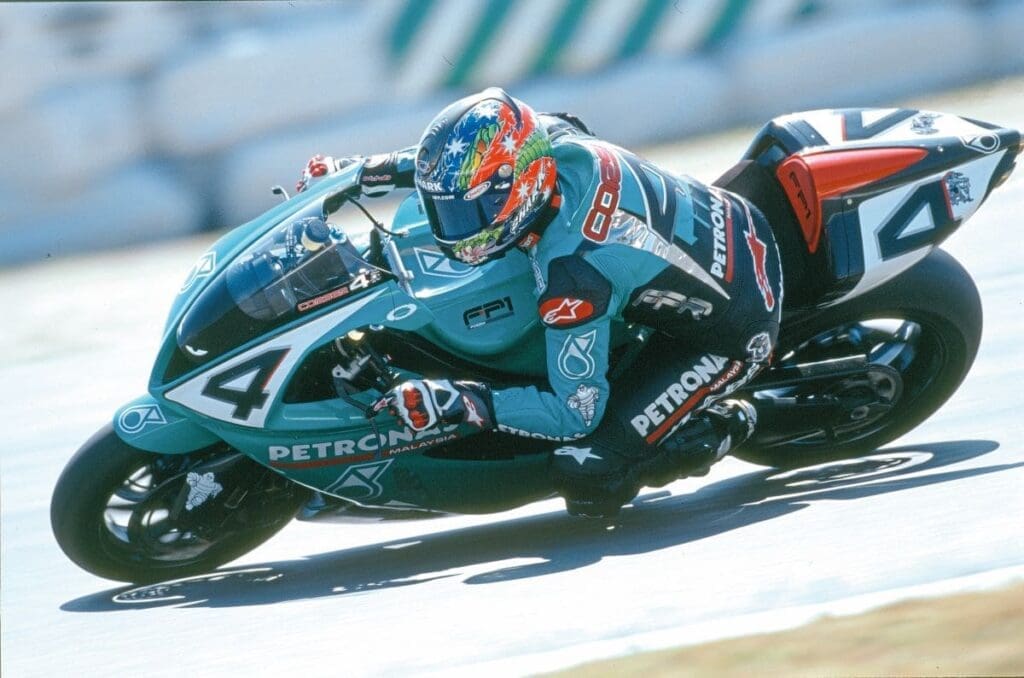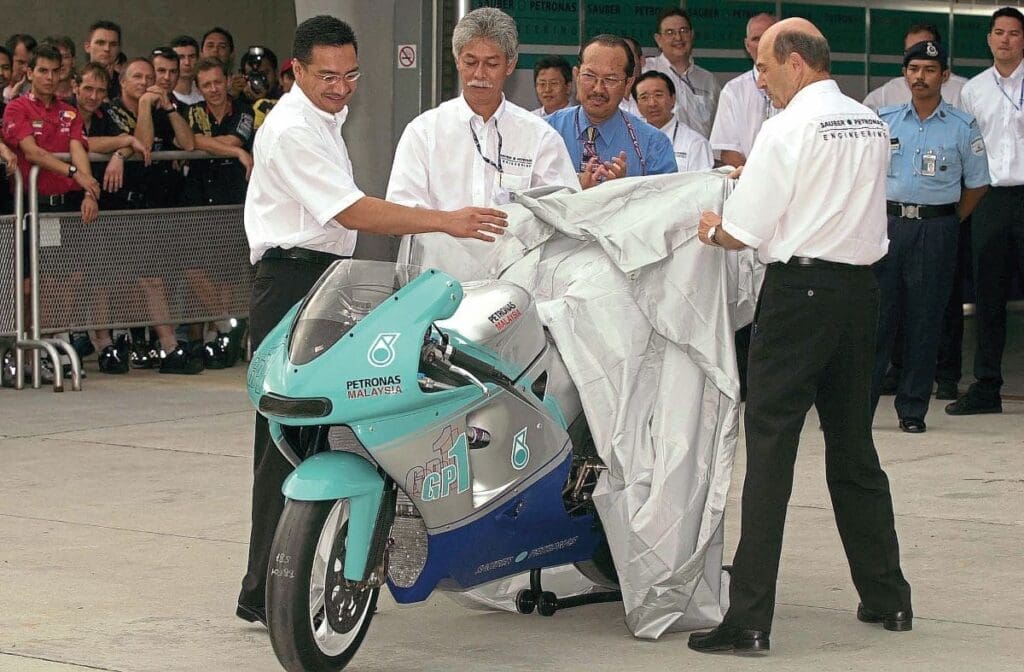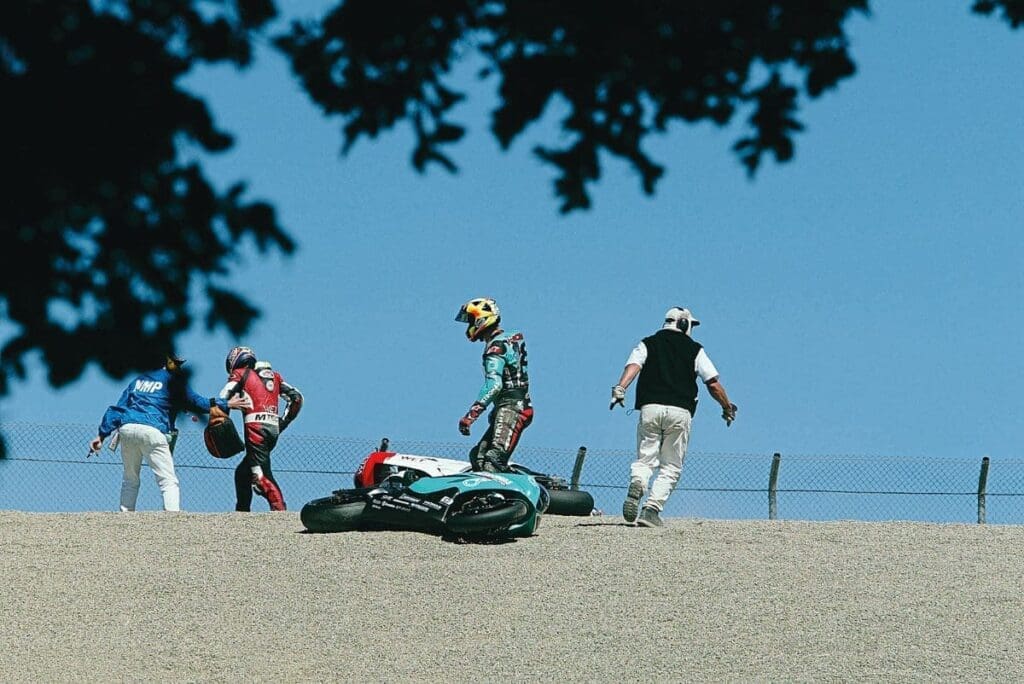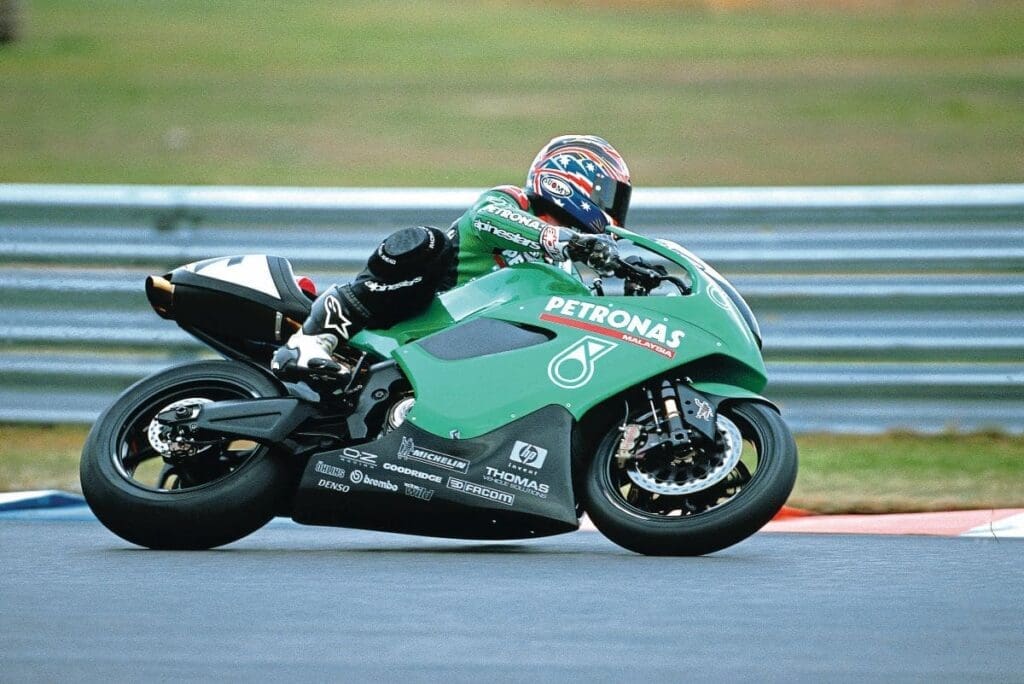Racing is clearly a matter of timing: it’s how the pecking order is worked out. But it also has a direct effect on whether a machine will be a success or not. The stars often need to align… They didn’t for the gorgeous Foggy Petronas FP1.

Words: Bertie Simmonds Photographs: Mortons Archive/Mark Wernham collection, FPR
The turn of the new century saw World Superbikes enter a period of change. For so long, the rules had been simple and effective: it was pretty much twins versus fours, Italy versus Japan.
From the start of the series in 1988, World Superbikes saw 750cc four-cylinder machines, ostensibly manufactured in Japan, in the form of Kawasaki’s GPX, ZXR and ZX-7R 750s, Honda’s VFR750RR RC30 and later RC45s, Suzuki’s GSX-R750 and Yamaha’s FZR750, OW-01 and later YZF750 take on Ducati’s booming twins, notably their 851, 888, 916, 955 and 996/998cc bikes.
So well-tuned were the rules that only tweaks were really required. Initially the rules limited four-cylinder motors to 750cc with a 165 kilo weight limit. The twin could go to 1000cc and – initially at least – a weight advantage of 140 kilos. Manufacturers also had to make a certain number of machines for homologation, dependent on size of the company. Honda – initially worried that they wouldn’t get the 1000 sales needed for their new RC30 – got 5000 on the first day… With Ducati, it was more whether they could actually build the 200 they needed to manufacture…
Every once in a while changes to the rules were made, mainly to the weight advantage held by the twins. Every season the four-cylinder riders would see Ducatis ahead larrup out of corners thanks to a torque and weight advantage. Quotes from the four-cylinder riders told you all you wanted to know. Scott Russell in early 1996: “The Ducati should be in Grand Prix racing, not world superbikes.” Aaron Slight: “There’s always another f***ing dickhead on a Ducati.”


Little by little weight was added to the twins, but – as this happened – so Ducati bored out their race machines to that 1000cc limit. In 1993 the twins had to weigh a minimum of 145 kilos, in 1994 the fours could now weigh 160 kilos and by 1995 the FIM had further changed things so that the twins’ weight was revised up by eight kilos and the four-cylinders down by another two, making the difference just five kilos between a twin and a four. By 1996 both twins and fours had to weigh 162 kilos… The ultimate irony: the original 25 kilo weight difference was supposed to be 25lb (11.3 kilos) as a way to lure Ducati into the series. But – the figure mysteriously changed from lbs to kilos when the figure went from rule-maker Steve McLaughlin (an American) over to the FIM in Europe…
Of course there were also the triples… Perhaps with a nod to manufacturers who historically built three-cylinder machines, like Triumph, the rules said you could have a triple of some 900cc. In the second half of 2001, Benelli entered the fray with talented development racer Peter Goddard on the Benelli Tornado 900 Tre but sadly it hardly made a dent on that year’s championship, scraping into the top 15 on just three occasions and earning the manufacturer just seven world championship points overall.
Things began to change. For 2000 in came the Honda VTR1000 SP-W/RC51/SP-1…It won the title first time out with Colin Edwards in 2000 and was the main challenger to Ducati and Troy Bayliss in 2001. After an amazing fightback in 2002, Edwards would take the VTR’s second and final title in SP-2 form before Honda abandoned WSB. The remaining 750cc bikes in the meantime had withered on the vine. Kawasaki’s ZX-7R was by 2002 six years old and even the much younger Yamaha YZF-R7, launched for the 1999 season, was hard-pressed to take on the twins.


MotoGP was also in a state of flux. From the mid-1990s to the early 2000s the stagnation of the class from a technical standpoint had seen the 500cc V4 as the bike to have, despite attempts by Honda and Aprilia to build a really competitive V-twin 500, with the associated weight advantage and therefore higher corner speed.
There was another way, of course: the three-cylinder 500… Kenny Roberts remembered well his battles with Freddie Spencer’s lighter, more nimble three-cylinder two-stroke 500 from his final season in 1983, and went out on a limb to build his own – the Modenas/Proton KR3 from 1997, but of course events would overtake Roberts’ initiative.
That was because MotoGP was changing, and it had to. Out were the two-stroke 500cc machines and in came four-strokes for 2002. Most forward-thinking manufacturers had begun development of their next-generation MotoGP machines years earlier – Yamaha, developing their inline four M1 and Honda, with an exotic V5 powerplant. And then there was Sauber Petronas…
Malaysian oil giant Petronas backed many machines in the smaller two-wheeled classes and – with Swiss engineering firm Sauber – were in Formula 1. They wanted to get into MotoGP and had what many felt was a 989cc three cylinder ‘sliver’ of a Formula 1 engine. At the end of 2001 at Shah Alam circuit in Malaysia, Niall Mackenzie would ride the bike.
Niall recalls: “I remember we were limited to 13,000rpm on the initial runs, but was told the motor would go to 16,000rpm, later we’d go to 15,000rpm. The motor didn’t sound like any triple I’d heard before – it was much more like an F1 car motor. The Sauber Petronas crew told me this motor should have ‘more than 200bhp’ and I believed them. With no tail-off after the power kicked in, I was hitting the rev-limiter so had a shift-light fitted around 14,250rpm. The bike would accelerate like a 500, but rather than a 2000rpm powerband this would have around double that… Wheelspin wasn’t an issue either thanks to an effective engine management system.”
The person behind this powerplant was Osamu Goto – who helped design engines for Honda’s glory years of F1 in the 1980s and 1990s. He joined Sauber in 1997 after a stint at Ferrari – it’s thought this triple was three cylinders based on that of a Ferrari F1 car of the late 1990s. Three cylinder motors in MotoGP rules could be 10 kilos lighter than fours or fives – hence Goto wanted to use a triple…
But suddenly it didn’t happen. Sauber Petronas’ MotoGP dreams stopped, suddenly, but that wasn’t the end for the motor. The biggest rumour was that the money Sauber wanted to go racing in GPs was too much, and when the project was mooted to go to WSB, this didn’t interest Sauber at all. Suddenly, and with plenty of Petronas money still sloshing around, as well as lots of work on the motor already having gone ahead, the plans changed.
Malaysian businessman David Wong saw an opportunity to bring together the Petronas backing, to the three-cylinder project but in production-based racing. This would mean building road bikes and this would mean he’d need help. Thankfully, he was already friends with a World Superbike icon: Carl Fogarty.
Wong had backed some of Carl’s early rides in WSB and even bought one of his race bikes. During the Briton’s rise to the top and subsequent four world championships, their friendship had continued. Carl retired from racing after his early season injury in 2000 and had worked as an ambassador for Ducati. But part of him – it seems – missed the element of competition.
An announcement was made that the project would focus on the World Superbike Championship with Fogarty as team boss, more a figurehead, with Nigel Bosworth in charge of ‘Foggy Petronas Racing.’ The move from prototype to production racing would give the new partnership a headache as 150 homologation production road bikes would need to be manufactured, in order for the race machine to be eligible. These bikes would be built by UK firm MSX International, called the ‘FP1’ and would be homologation specials and cost around £25,000 each – this would be the beginning of a family of bikes.

The production ‘road’ FP1 suffered a number of delays until in 2005 it was announced that the bikes were available to buy. Unfortunately they had to be purchased direct from Malaysia. Then – five years later – a number of FP1s (around 60) were ‘discovered’ in Essex. Apparently 75 bikes had been final assembled in Essex and a further 75 in Malaysia. In 2012 the 130 bikes were bought by Malaysian company, Momoto, ready to be re-branded as Momoto MM1s and be sold – almost a decade after they should have been. Rumours of bikes being seized by the Malaysian government pending legal action were rife. Since then some bikes have trickled through to the road, with a few journalists having ridden one in the last decade or so.
Road bikes were a means to an end – to go racing. And the FPR team had to come together quickly. Even with a customer race bike this would take time – but they were also developing a race machine from a clean-sheet of paper. Joining Bosworth was Steve Thompson (chief engineer), Neil Bramwell (Foggy’s biographer) would head-up marketing and PR, and let’s not forget Mrs Fogarty – Michaela – would also be part of the team. Chief executive would be a chap called Murray Treece. Riders were hired: former champ Troy Corser and BSB front-runner James Haydon, and premises would be a new £1.5 million set-up in Burton-upon-Trent – complete with prayer rooms for the number of Muslim engineers coming from Malaysia and Petronas.
Petronas contacted Suter Racing Technology (formed by Eskil Suter, former GP rider and engineer now running his own Swiss-based engineering company) to work on the engines. These had to go from being 989cc to 899.5cc, to fit in with the then-current WSB triple rules.
Chassis-wise, all the latest kit would be used. The twin-spar welded alloy frame would grasp the latest Ohlins forks, with Brembo Monobloc radial brakes, OZ lightweight wheels and Michelin race slicks. The motor would be reversed in the frame, with exhausts (Micron helped develop some systems) exiting under the seat. Power for the race bike was around 185bhp at 13,500rpm with around 80lb-ft at 11,000rpm. The bike was supposedly bang on the 162 kilo limit and the swoopy lines were influenced by Carl himself – who didn’t want a bulky-looking bike, but more svelte like a Ducati. In Petronas house colours, it was a striking looking bike…
The team launch was an impressive affair in London. Seasoned race journalist Gordon Ritchie said: “It already looks like the culmination of two or three years of racing. The bike looks very good close up, very impressive and at least we know that they’ve built two of them! Looking at this bike it actually seems better up close and the detail is better than the Ducati MotoGP bike I saw at the Mugello GP.”
Sadly, the machine never made grid in 2002, but the bike did make a few high-profile appearances, such as a handful of demo laps at Brands Hatch and with Foggy on board at a Commonwealth Games parade in London.
By the time the first race of 2003 occurred, everyone wanted to know how well the bike would go. “We’re here to save this championship,” Foggy would say. Which in some ways was right, thanks to the championship losing some of its biggest names for 2003 (Bayliss and Edwards went to MotoGP) while Honda left as a factory team. Many now considered WSB a ‘Ducati cup.’

Amazingly at the 2003 season opener at Valencia, Corser put the bike in 4th place on the grid, crashing out of 9th in the race. Haydon would take 12th. Race two was better: Corser 7th and Hayden was a DNF. Foggy said at the time: “If anyone would have told me six months ago that Troy would get us on the front row for our first race I’d have said they were crazy…” It was a dream start but then reality kicked in with the bike scoring 17 DNFs in the first nine races of the year. Corser would end the season in 12th overall.
Haydon would leave the team to be replaced by Chris Walker for 2004. By now more of the Japanese manufacturers had left in part due to a new Pirelli control tyre rule and it was tyre choice that helped Walker give the team its first podium (3rd) at the opening round at Valencia, on a damp but drying track.
Behind the scenes Suter’s firm would be replaced by Ricardo as engineering partners on the engine. And the engine was promised to improve from the second half of that season. Before that Corser – who would chalk up two pole-positions that year for the team – also led for much of the race at Misano before being beaten by Regis Laconi. This 2nd place would be the bike’s best finish.
Both riders would leave to be replaced by Aussies Garry McCoy and Steve Martin for 2005 – quality riders (one a former MotoGP race winner, one a former Aussie superbike champ) – and Jack Valentine came in as team manager. Even with improvements to the motor, more revs, power and less weight, the best they could do was finish the season in 18th (Martin) and 22nd (McCoy.) Martin would stay on for 2006 to be joined by young British charger Craig Jones, but by now the Japanese had returned to the series and the 900cc triple was seriously under-gunned and the project ended at the end of that season, Martin was the best overall finisher of the two FPR riders in 21st place overall.

So what went wrong? One ex-rider for the team said: “If they’d spent as much on the bike as they did on the hospitality, things would have been better…”
Maybe, but then the bike was doomed pretty much from the start. Engineering woes or the actual architecture of the motor aside, the big thing was that the bike and team were overtaken by events. With MotoGP going four-stroke in 2002 and WSB having to respond to Japanese teams leaving the class to go to MotoGP (more so after the introduction of a one-make tyre) suddenly the WSB grid could have 1000cc four-cylinder, three-cylinder and twin-cylinder bikes from 2003. In that year only Ducati and Suzuki kept factory teams in the series, along with Foggy Petronas. And against 1000cc V-twins and fours, the 900cc triple was woefully out-gunned.
With a £30 million budget, in three seasons the bike took two pole positions and two podiums. So, how do we look at the Foggy Petronas Racing story? If it was a vanity project, it was an entertaining one that added colour to the-then dull WSB grid and – while the bike and team never quite won a race – you can’t deny that to go from clean-sheet to a front-row start in 16 months was very impressive. It was clearly a case of ‘wrong bike, wrong time…’
It’s a shame that they couldn’t just take that top-step finish, or even carry on in WSB with a customer machine. We wonder today that if we were to ask Foggy what was easier: eating fried tarantulas, an ostrich’s bum or a camel’s penis to win ‘I’m a Celebrity’, or getting to the WSB grid with a brand-new bike in 16 months, whether he’d say the former over the latter…
Foggy Petronas Racing timeline
March 2001: Sauber Petronas 989cc three-cylinder engine unveiled.
October 2001: Sauber Petronas GP-1 unveiled at Sepang during the Grand Prix race weekend. Machine later tested at Shah Alam by Niall Mackenzie.
November 23, 2001: Petronas sign a five-year deal with Carl Fogarty to run their nascent World Superbike team.
December 2001: Carl Fogarty announces that 10,000 road bikes will be built – eventually.
December 18, 2001: James Haydon signs with the team.
January 18, 2002: Troy Corser signs.
January 24, 2002: Former racer Eskil Suter’s (pictured) Racing Technology becomes engine developer for both race and road bikes of 899.5cc.
February 2002: Clay model built.
March 2002: Wind tunnel testing begins.
May 21, 2002: £1.5 million team workshops opened in Burton-upon-Trent
June 2002: Team launch in London. Fogarty unveils the two machines and riders in front of an ice sculpture of the bike, while Queen’s ‘One Vision’ blasts out.
July 28, 2002: The FP1 does demo laps at Brands Hatch WSB round.
March 2, 2003: New WSB season opens with 1000cc four-cylinders allowed. Only Suzuki joins. FPR takes 4th on the grid with Troy Corser…
February 29, 2004: Chris Walker takes 3rd at season opener at Valencia. Corser takes 2nd place at Misano, and two pole-positions in Germany and France.
October 8, 2006: Last round of the WSB season and the last race for the FPR FP-1 sees Steve Martin in 21st overall and Craig Jones in 27th. As manufacturer, Foggy Petronas is 6th and last with 19 points.




